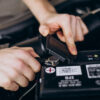Battery Charging Methods: How to Safely Charge Your Vehicle Battery
A properly charged battery is essential for the smooth operation of your vehicle’s electrical systems. Whether you’re dealing with a dead battery or simply maintaining its health, knowing how to safely charge your vehicle battery is crucial. In this guide, we’ll explore various battery charging methods and provide tips for ensuring a safe and effective charging process.
Understanding Battery Charging
Before we delve into the charging methods, it’s important to understand how battery charging works. A vehicle battery stores electrical energy in the form of chemical energy, which is converted back into electrical energy when the battery is charged. The charging process involves applying an external electrical current to the battery, causing chemical reactions that recharge the battery’s cells.
1. Using a Battery Charger
One of the most common and effective methods of charging a vehicle battery is using a battery charger. Battery chargers come in various types, including trickle chargers, float chargers, and smart chargers. Trickle chargers deliver a low, steady charge over an extended period, making them ideal for maintaining the charge of a battery during storage. Float chargers are similar but automatically adjust the charging rate based on the battery’s voltage level. Smart chargers, also known as intelligent chargers, monitor the battery’s condition and adjust the charging process accordingly, minimizing the risk of overcharging or undercharging.
2. Jump-Starting the Battery
In situations where your vehicle’s battery is completely dead, jump-starting the battery is a common method of providing a temporary charge to start the engine. This method involves using jumper cables to connect the dead battery to a fully charged battery or another vehicle’s battery. It’s important to follow the correct procedure and safety precautions when jump-starting a battery to avoid damage to the vehicle’s electrical system or personal injury.
3. Using a Battery Maintainer
A battery maintainer, also known as a battery tender or trickle charger, is a device designed to keep a battery charged at a steady rate over an extended period, typically during storage. Battery maintainers deliver a low, constant charge to the battery, preventing it from discharging completely and prolonging its lifespan. They are particularly useful for vehicles that are not used frequently, such as classic cars or seasonal vehicles like motorcycles or boats.
Safety Tips for Battery Charging
Regardless of the charging method used, it’s essential to prioritize safety to prevent accidents and damage to the battery or vehicle. Here are some safety tips to keep in mind when charging your vehicle battery:
- Always read and follow the manufacturer’s instructions for the battery charger or maintainer.
- Ensure proper ventilation in the charging area to prevent the buildup of explosive gases emitted by the battery.
- Use insulated tools and wear protective gear, such as gloves and safety glasses, when handling the battery or connecting cables.
- Avoid smoking or creating sparks near the battery, as it may contain flammable gases.
- Disconnect the battery from the vehicle’s electrical system before charging to prevent damage to sensitive electronic components.
- Monitor the charging process closely and disconnect the charger promptly once the battery is fully charged to avoid overcharging.
Conclusion:
By following these battery charging methods and safety tips, you can ensure a safe and effective charging process for your vehicle battery, maintaining its performance and longevity for years to come.




